or: How the Germans could become more beautiful and happier (Ricarda Huch)
“I believe that if all Germans cycled, they would lose their dull sensuality and be happier and more agreeable.” (Ricarda Huch to Richard Huch 1896)
The Free Hanseatic City of Bremen was a pioneer in the successful promotion of cycling in Germany in the 19th century1. And today, every second cyclist in Bremen is a woman – at least. But that was by no means the case 150/160 years ago. The bicycle – initially developed as a penny-farthing – was a male means of transport. Sons of wealthy merchants, factory owners and aristocrats could afford such a thing, because in 1880 a penny-farthing cost at least 200 marks, which was unaffordable for the working class. Even in 1912, the cheapest touring bike cost 30 marks, the equivalent of two weeks’ wages for a worker2.
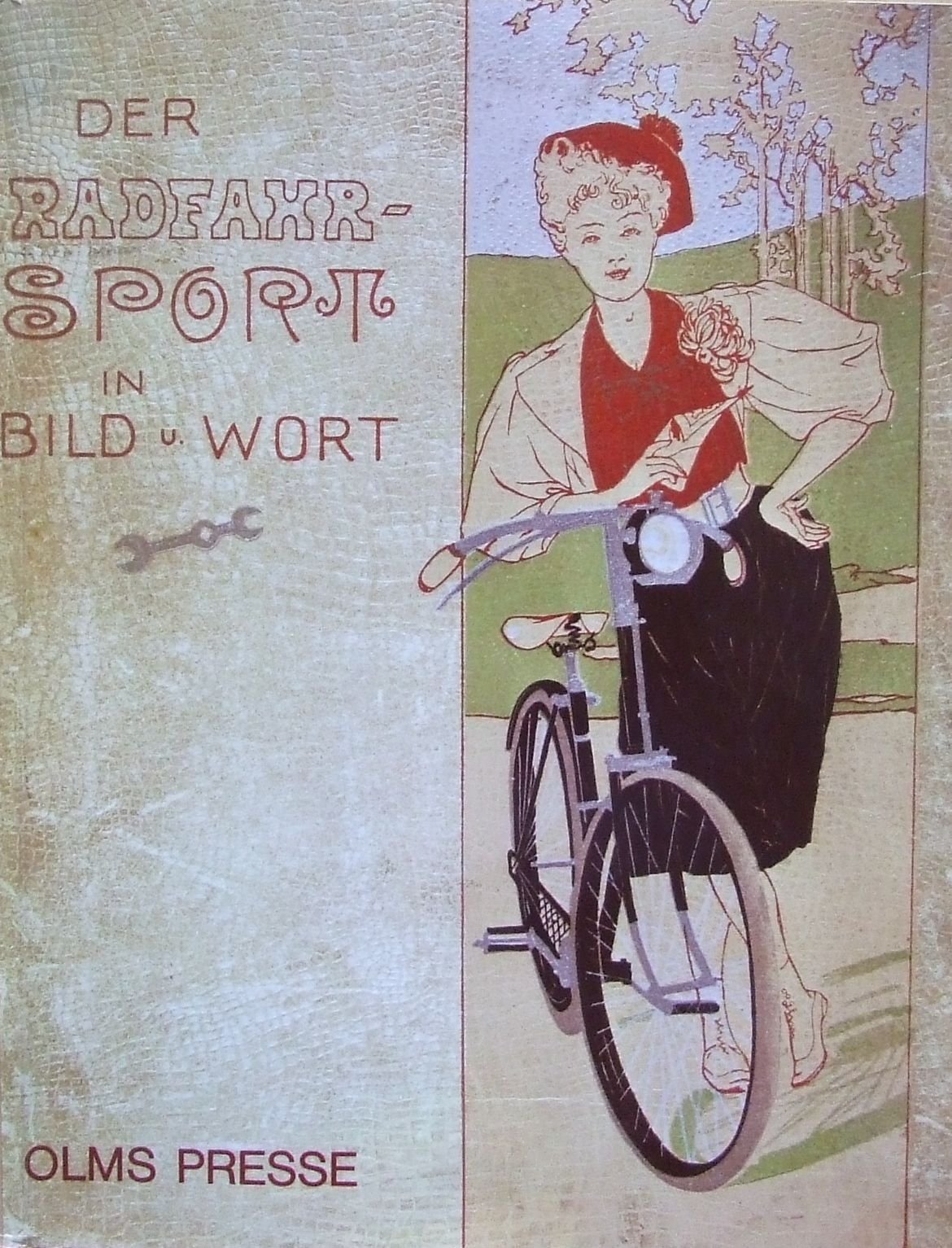
The safety bicycle and pneumatic tyres changed everything (Foto: Museumsdorf Cloppenburg – Niedersächsisches Freilichtmuseum)
There were plenty of women who fancied sport and exercise, and the bicycle was an attractive, if dangerous, option. But there were essentially three obstacles standing between bicycles and women: social norms and (consequent) clothing, the slow pace of technological change, and the price of a bicycle.
It was only with the invention of the “safety bicycle” in 1885 (and pneumatic tyres in 18883), its mass production and the resulting drop in prices that the bicycle became accepted by the entire population – and thus also by women4.
“The decisive years of its (the bicycle’s, B.W.) social acceptance fall in the peace period between 1871 and 1914.”5 And for women, “between 1893 and 1897 (…) a profound change in the function and significance of women’s cycling took place. The extraordinarily few pioneering women cyclists at the beginning had until then faced manifold obstacles, publicistic hindrances and strategies of oppression.”6 But with the economic developments described above, this changed: “The number of women cyclists rose sharply within a short time, and cycling was quickly considered ‘chic’ in broader middle-class circles.”7
Aline von Kapff: It all started with the penny-farthing
The penny-farthing was dangerous and expensive, but there was at least one woman in Bremen who dared to ride up high: Aline von Kapff (1842 – 1936)8, daughter of the Kapff family of wine merchants, who fearlessly climbed her penny-farthing and dismounted again with a daring leap over the handlebars.
Aline von Kapff came from a liberal and wealthy family and was thus able to lead a relatively independent and rather unconventional life. She remained unmarried and studied painting in Munich and Paris. Probably she did not suffer any social disadvantages with her sporting activities; on the contrary, she became a role model for many other women in Bremen, even if “society” certainly frowned at her activities: “Only a few females had dared to do it (cycling), among them Anna Hagens/Pavenstedt and Aunt Aline v. Kapff, who initially made her ‘Kaisersprung’ in front of every oncoming carriage, i.e. hopped down from the saddle to the front and then, standing on the ground with both feet above the wheel, waited until the ‘danger’ had passed.”11
Aline Kapff was no coward in other ways either, as she showed in 1912 in her skillful and successful defence of the director of the Bremen Kunsthalle, Gustav Pauli, who had “dared” to buy paintings by Impressionists, including Vincent van Gogh’s Field of Poppies: on 29th March 1912 there was an event on this. She had invited painters such as Konrad von Kardorff and Rudolf Tewes, art experts such as Alexander von Salzmann, Julius Meier-Graefe and Alfred Lichtwark, as well as the writers Rudolf Alexander Schröder and Alfred Heymel, and other friends, who were to enlighten the incensed Bremen merchants about the value of this new art movement. “The protest meeting ended in ‘a storm of applause for the director of the Bremen Kunsthalle’ who had made the purchases.”12 Her circle of friends in Bremen also included the ceramist and landscape painter Walter Magnussen and his wife, the sculptor Anna Magnussen-Petersen and, of course, Paula Becker-Modersohn and Magdalene Pauli aka Marga Berck (“Summer in Lesmona”).
Ricarda Huch: Happiness on the Safety Bicycle
It was also a stroke of luck for Bremen that in Bremen “a woman learned to ride a bicycle and reported on it, who later became famous because of her writing abilities: Ricarda Huch (1864-1947).”13
She lived in Bremen from 1896 to 1897 and began cycling in November 1896. In her letters to her lover and brother-in-law Richard Huch, she recounts her experiences and feelings: “I’ve been cycling since the day before yesterday. Today I was really happy to have started (…) this physical exercise of strength does refresh me.”14 And a few months later: “The day before yesterday I started again, and from that moment on a feeling of bliss took hold of me that I don’t want to lose again. It is too beautiful.” She soon acquired her own bicycle and went on many bicycle tours15.
It should be added here that it was precisely at this time that the first cycle paths were laid out and designated in Bremen: in 1897, the first cycle paths with a width of 2.50 m were built on Hollerallee, Parkallee and Osterdeich16.
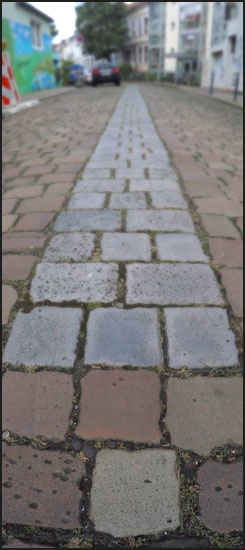
Bremen today: Flat stones in Taubenstraße mark an old cycle path in the middle of the road (Foto: Beatrix Wupperman)
In the narrow streets of the old town, special lanes in the form of smoothly polished Mansfeld slag stones in the middle of the carriageway were provided for cyclists at that time; these can still be seen in Linienstraße and Taubenstraße17.
Ricarda Huch clearly expresses what many people still feel when cycling today. When we made the film “Beauty and the Bike” in Bremen and Darlington/UK, we worked with girls from both cities and traveled with them to the other city. The reaction of the English girls to cycling in Bremen was quite comparable to Ricarda Huch’s feelings of happiness. Harri Endersby describes it as liberation, enrichment, a pick-me-up before school and much more18.
Emancipation through cycling?
An interesting and controversial question is whether women’s cycling in the late 19th century and early 20th century contributed to their emancipation. Aline von Kapff and Ricarda Huch were able to afford cycling not only financially but also, and above all, in terms of their inner freedom vis-à-vis social norms. The latter was in fact demanded of women who wanted to cycle at that time.
Amalie Rother, probably the first Berlin cyclist19, publicly ventured onto a bicycle (initially on a tricycle, from 1893 also on a two-wheeler, a “ladies’ bicycle”) together with her friend Clara Beyer in 1890 (Ida Caspari joined them in 1892). She describes very clearly what could happen to a woman on a bicycle: After a few test rides on quiet forest roads in the Berlin countryside, “we dared to ride through the city at the earliest dawn and finally one fine afternoon we started from Blücherplatz. Immediately hundreds of people gathered, a herd of street boys prepared to run with us, remarks of the most amiable kind fell in heaps, in short, the thing was the purest running of the gauntlet (…) It was peculiar that the rudest and meanest behaviour was not of the lowest class of people, but of the rabble in glacé gloves, and to the shame of my fellow countrywomen I am sorry to say it, women who, according to their appearance, belonged to the better classes. ‘Ugh, how vulgar!’ was the mildest thing to be heard from ‘beautiful’ lips.”20
But did cycling liberate women, did it contribute to equality, to emancipation? The Austrian writer and women’s rights activist Rosa Mayreder (1858 – 1938) is convinced of this: “The bicycle has contributed more to the emancipation of women from the higher social classes than all the efforts of the women’s movement put together.”21 Other voices oppose this: “The view still haunting some publications that the bicycle emancipated women in a political sense as well is untenable.”22 “Medium- or long-term emancipatory effects of this process (the introduction of the women’s bicycle and the lifting of the ban on women riding bicycles, B.W.) (…) should, however, only be conceded very cautiously (…) In any case, something like equality (…) remained limited to the rather formal cross-gender access to the bicycle. Accordingly, one may continue to argue about the degree of importance of the bicycle for the emancipation of women, and also about whether imperial-era women really became more mobile, independent and self-reliant through the ‘conquest’ of the bicycle and developed a new self-confidence.”23
The situation of women in the 19th and early 20th century
Here, however, we must bear in mind the situation of women in the 19th century in Europe (and the United States): No woman – not even an upper-class woman – was allowed to vote or be elected. No woman had a right to education; higher education was often only possible for them in the artistic field. Ricarda Huch was a great exception, she earned her doctorate at the University of Zurich as early as 1892 “with a historical thesis on ”The Neutrality of the Confederation during the Spanish War of Succession”.”24 “Everything they did or decided had to be approved by either their father or their husband. 252627
In addition, women in Germany had an average of 4.17 children in 1901, today the average is 1.542829. My great-great-grandmother Elise Johanna Tips (1830 – 1918) gave birth to 8 children in 23 years (1851 – 1874) in her marriage to Otto Wuppermann (1818 – 1907)30. Her mother-in-law Anna von Oven, (married: Wuppermann) gave birth to 13 children between 1807 and 1825, but she died at the age of 43 when her youngest child was just starting to walk31. And that’s how it was for many women: pregnancy and childbirth were high risk factors in a woman’s life. My great-grandmother Ameli Simonsen (1867 – 1898) died of an embolism a few days after the birth of her youngest child, my grandmother Anne-Marie Hollensen, at the age of 32, just like the painter Paula Modersohn-Becker (1876 – 1907)32.
In this dramatic context we have to put the question of women’s emancipation and cycling and perhaps also take note of the following: “The Federation of German Cyclists (BDR) only came out in favour of women’s cycling as a component of the BDR by resolution at its general meeting in March 1967.“33 But more than 60 years earlier in the struggle for the right to vote, “the suffragette movement used the bicycle and (it. B.W.) thus again functioned as a means of emancipation.”34 And the “US women’s rights activist Susan B. Anthony wrote in 1896: “I think the bicycle has done more to emancipate women than anything in the world. I rejoice every time I see a woman ride by on a bicycle. It gives her a sense of self-reliance and independence the moment she does it.”35
Cycling, a privilege of upper-class women?
Yes, it is true that “cycling by the female sex (…) has from the beginning (…) been a matter for the upper bourgeois classes”36. But “since Aline von Kapff belonged to the urban upper class, her behaviour had a certain exemplary function. Upper-class women had the advantage of greater material and intellectual independence. It is therefore not surprising that women cyclists made a name for themselves in these social circles at a very early stage.”37
In addition, with “the spread of cycling also for women (…) social taboos were undoubtedly broken, cultural patterns questioned and widespread prejudices of the basic patriarchal structure exposed”38. And on the basis of the clothing question and discussion (also an important point in Amalie Rother’s work39), we can see how pervasive the change was: The corset and the skirt were suddenly up for discussion!40 Only a few decades later, in the “Golden Twenties”, the corset had had its day as a garment for a lady, and trousers made their triumphant entry into female fashion41. The bicycle certainly played its part.
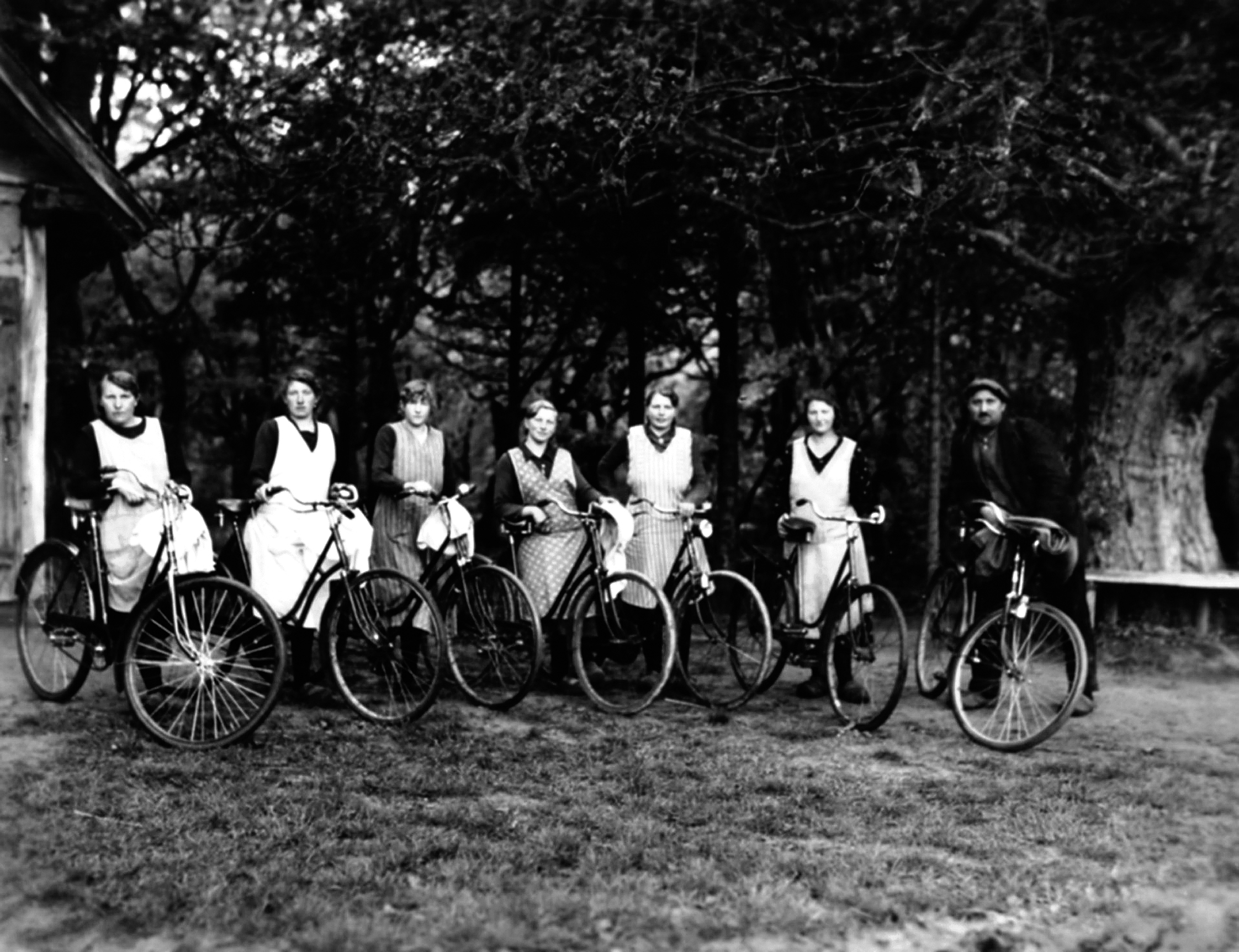
Women Cyclists in Northern Germany (Foto: Museumsdorf Cloppenburg – Niedersächsisches Freilichtmuseum)
We also have to take note that there was enormous social resistance to women riding bicycles, including from women themselves. Superficially, mainly medical reasons were put forward42. For us today, however, it is clear that it was less about women’s health than about their freedom of movement gained with the bicycle.
Of course, the bicycle, or more precisely, the women who rode bicycles, did not bring about social changes on their own. But history does not run in a linear fashion; changes have many mothers and fathers, not least dialectical processes promote upheavals. The working class in general openly used the bicycle as a means of emancipation43. And for women, the bicycle offered the great opportunity to move actively and get from A to B without male help or accompaniment: after the horse, the next means of independent mobility for women.
Women’s rights activists fought for the bicycle
In Germany and the Netherlands, women’s rights activists fought for the right to ride bicycles as a means of liberation, to escape the city and to satisfy the desire for physical development.44 The Dutch doctor Catherine van Tussenbroek made this particularly clear in her speech at the “National Exhibition on Women’s Work” in The Hague in 1898: the bicycle functioned as excellent proof of one’s physical abilities45. It could strengthen one’s self-confidence and overcome the feeling of powerlessness, uselessness and economic dependence with the step into professional life46. And the German women’s rights activist Lily Braun reinforced this in 1901: “From their earliest childhood, girls would be restrained in their freedom of movement by their restrictive gowns,” while boys would romp outside and prove themselves physically. “This situation, however, had recently changed because of the bicycle”47. Lily Braun calls the bicycle a strong emancipator, “whose effect in favour of the self-liberation of the female sex (…) is clearly evident.”48
By the 1920s at the latest, the bicycle had become a means of mass transport and was thus used by women from all social classes – until the first automobiles appeared and many middle and upper class women “switched sides” again.49
This discussion about “emancipation and bicycles” or more generally: “emancipation and mobility” finds its parallel in the question of car driving licences for women in countries that are still extremely patriarchal today, such as Saudi Arabia. I think hardly anyone here in the “West” does not support the struggle of the (few openly active) women for driving licences and self-determined car use. Because the car gives Saudi women the chance for self-determined mobility. And I have never heard anybody saying that this struggle did not also serve the emancipation of these women.50
And that’s how it was for women in the 19th century with the bicycle. As Frank Preisner told us into the camera, “A bicycle, that was the fastest land vehicle a single person could move.”51 And women belonged and still belong to those people. Women like Aline von Kapff, Ricarda Huch and Amalie Rother with their friends Clara Beyer and Ida Caspari.
And once again Ricarda Huch: “I have the feeling I would lose years of my life if I didn’t cycle.”52
She sums up her political view of the bicycle with a wink: “I think if all Germans rode bicycles, they would lose their dull sensuality and become more beautiful and happier.”53
Finally, a personal note: My girls’ school in Hamburg had the beautiful name: “Hochrad”54.
This article was first published on the website of the “Bremer Frauenmuseum” in June 2021: https://bremer-frauenmuseum.de/2021/06/18/die-frau-und-das-fahrrad/
Footnotes
1 Reiss, Florian: Zum Beispiel Oldenburg. Die Anfänge des Fahrradfahrens in Nordwestdeutschland. In: Preisner, Frank (Hrsg.): fahrtwind. Kulturgeschichte des Fahrrads im Nordwesten, Museumsdorf Cloppenburg 2015, p. 67 und Wupperman, Beatrix: https://www.bremenize.com/fahrradfahren-in-bremen-die-erste-jahre/ Bremen, 29th August 2016
2 Schwarzwälder, Herbert: Geschichte der Freien Hansestadt Bremen II, Von der Franzosenzeit bis zum Ersten Weltkrieg (1810 – 1918), Bremen, erw. Auflage 1995, S. 484f
3 König, Johann-Günther: Fahrradfahren, Von der Draisine bis zum E-Bike, Stuttgart 2017, p. 140
4 Wolter, Gundula: Hosen, weiblich. Kulturgeschichte der Frauenhose, Marburg 1994, p. 155, also König: Fahrradfahren, p. 139f
5 See Reiss, Oldenburg, p. 67
6 See Dröge, Kurt: Von der Bekleidung beim Radfahren der Damen. In: Preisner: fahrtwind, p. 122
7 See Dröge: Bekleidung beim Radfahren, p. 122
8 https://second.wiki/wiki/aline_von_kapff https://de.wikipedia.org/wiki/Aline_von_Kapff http://www.bremerfrauengeschichte.de/2_Biografien/kapff.html a9nd https://www.kreiszeitung.de/lokales/bremen/bremer-frauen-geschichten-malerin-kunstmaezenin-aline-kapff-9675509.html
9 Grassick, Richard: Interview with Frank Preisner and Florian Reiss: https://www.bremenize.com/en/das-vieh-scheut/ m10inute: 5:13 – 5:44, König: Fahrradfahren, p. 132f
10 https://second.wiki/wiki/aline_von_kapff and https://de.wikipedia.org/wiki/Aline_von_Kapff
11 Reiß, Florian Nikolaus: Vom Radfahren in Bremen – Die Bremer Fahrradgeschichte bis zum Ersten Weltkrieg, in: Bremisches Jahrbuch, Band 94, 2015, p. 132 – 162, hier: p. 148
12 https://second.wiki/wiki/aline_von_kapff and https://de.wikipedia.org/wiki/Aline_von_Kapff
13 see Reiß: Bremer Fahrradgeschichte, p. 149, about Ricarda Huch in general https://en.wikipedia.org/wiki/Ricarda_Huch and https://de.wikipedia.org/wiki/Ricarda_Huch
14 see Huch, Ricarda: Du mein Dämon, meine Schlange…Briefe an Richard Huch 1887 – 1897, p. 550, quoted from Reiß: Bremer Fahrradgeschichte, p. 149
15 see Huch: Schlange, p. 612, quoted from Reiß: Bremer Fahrradgeschichte, p. 150
16 Froitzheim, Thomas, Lüers, Arne: Radfahren in Bremen, in: Roder, Hartmut (Hrsg.): Verkehr in Bremen, buten un binnen, Fähren, Fahrräder, Flugzeuge, Bahnen, Busse & Taxen, 3. Auflage, Bremen 1990, p. 43
17 Wupperman, Beatrix: https://www.bremenize.com/fahrradfahren-in-bremen-die-erste-jahre/ , Bremen 29th August 2016
18 See a short version of the interview with Harri here https://www.youtube.com/watch?v=M88sF-rvul0 minute 06:28 bis 06:42 „It’s just been so liberating.“ Read also: Wupperman, Beatrix/Grassick, Richard: Beauty and the bike, Darlington Media Group 2009
19 https://grossstadtgeschichten-berlin.de/items/show/927
20 see Rother, Amalie: Das Damenfahren, München 1897, in: Preisner: fahrtwind, p. 133
21 see Eickelberg, Gudrun: https://www.bremenize.com/en/maenner-und-frauen-der-kleine-unterschied-beim-radfahren/#more-3078
22 König: Fahrradfahren, p. 150
23 see Dröge: Bekleidung beim Radfahren, p. 130
24 Because German universities did not allow women to graduate, Huch left Braunschweig in 1887 and moved to Zurich to take the entrance examinations for the University of Zurich. She matriculated into a PhD program in history and received her doctorate in 1892 for a dissertation on “The neutrality of the Confederation during the Spanish War of Succession” (Die Neutralität der Eidgenossenschaft während des spanischen Erbfolgekrieges).
https://en.wikipedia.org/wiki/Ricarda_Huch and https://de.wikipedia.org/wiki/Ricarda_Huch
25 https://paris1899.de/2012/08/21/die-viktorianische-frau-idealbild-gesellschaftliche-bedeutung/
26 https://www.mappr.co/thematic-maps/women-rights-of-vote/ and https://de.wikipedia.org/wiki/Frauenwahlrecht_in_Europa
27 https://www.greelane.com/geisteswissenschaften/geschichte–kultur/free-love-and-womens-history-3530392/
28 http://www.sozialpolitik-aktuell.de/files/sozialpolitik-aktuell/_Politikfelder/Bevoelkerung/Datensammlung/PDF-Dateien/abbVII1b.pdf
29 https://www.wirtschaftundschule.de/unterrichtsmaterialien/unternehmen-und-markt/hintergrundtext/geburtenrate-vor-1914-als-jede-frau-noch-vier-kinder-bekam/
30 Elise Wuppermann geb. Tips: Texanische Tagebücher 1850 – 1865 und Dietz, Walter: Chronik der Familie Wuppermann, Band II, Leverkusen-Schlebusch 1965, p. 83ff
31 Dietz: Wuppermann, Band II, p. 36ff
32 https://en.wikipedia.org/wiki/Paula_Modersohn-Becker and https://de.wikipedia.org/wiki/Paula_Modersohn-Becker
33 https://de.wikipedia.org/wiki/Geschichte_des_Frauenradrennsports
34 https://www.diamantrad.com/blog/fahrrad-mittel-emanzipation/
35 https://www.diamantrad.com/blog/fahrrad-mittel-emanzipation/
36 see Dröge: Bekleidung beim Radfahren, p. 130
37 see Reiß: Bremer Fahrradgeschichte, p. 148
38 see Dröge: Bekleidung beim Radfahren, p. 119
39 see Rother: Damenfahren, in Preisner: fahrtwind: p. 136ff
40 Dröge: Bekleidung beim Radfahren, p. 122ff
41 http://www.hilfreich.de/mode-zu-beginn-des-zwanzigsten-jahrhunderts-1900-1920_5373
42 Grassick, Richard: https://www.bremenize.com/en/das-vieh-scheut/ Interviews with Frank Preisner and Florian Nikolaus Reiß: minutes 4:49 – 5:12 und 5:47 – 7:08
43 Grassick, Richard: https://www.bremenize.com/en/das-vieh-scheut/ Interviews with Frank Preisner and Florian Nikolaus Reiß: minutes 3:32 – 4:03
44 Ebert, Anne-Katrin: Radelnde Nationen. Die Geschichte des Fahrrades in Deutschland und den Niederlanden bis 1940, Frankfurt am Main 2010, p. 131ff
45 Tussenbroek, Catharine van: Over het tekort aan levensenergie bij onze jonge vrouwen en meisjes. Rede uitgesproken op de nationale Tentoonstelling, Amsterdam 1898, zitiert aus: Ebert: Radelnde Nationen, p. 132
46 Tussenbroek: levensenergie, p. 6 quoted from : Ebert: Radelnde Nationen, p. 219
47 Ebert, Radelnde Nationen, p. 132
48 Braun, Lily: Die Frauenfrage. Ihre geschichtliche Entwicklung und ihre wirtschaftliche Seite, 1. Auflage 1901 (Nachdruck), Berlin/Bonn 1979, p. 189, quoted from: Ebert: Radelnde Nationen, p. 132
49 As did my grand-mother Anne-Marie Hollensen, who loved driving a car. Nobody would be allowed to drive her car! My mother Ursula on the other side cycled into her old age – but in most cases drove a car.
50 https://en.wikipedia.org/wiki/Women_to_drive_movement and https://www.welt.de/politik/ausland/article169166760/Warum-Saudi-Arabien-sich-ploetzlich-so-eilig-modernisiert.html
https://praxistipps.focus.de/frauenrechte-saudi-arabien-was-frauen-duerfen-und-was-nicht_117970
51 Grassick, Richard: https://www.bremenize.com/en/das-vieh-scheut/ Interview with Frank Preisner: Minute 2:10 bis 2:14
52 see Huch: Schlange, p. 612, quoted from Reiß: Bremer Fahrradgeschichte, p. 150
53 see Huch: Schlange, p. 612, quoted from Reiß: Bremer Fahrradgeschichte, p. 149f
54 https://de.wikipedia.org/wiki/Gymnasium_Hochrad https://www.gymnasium-hochrad.de/geschichte/


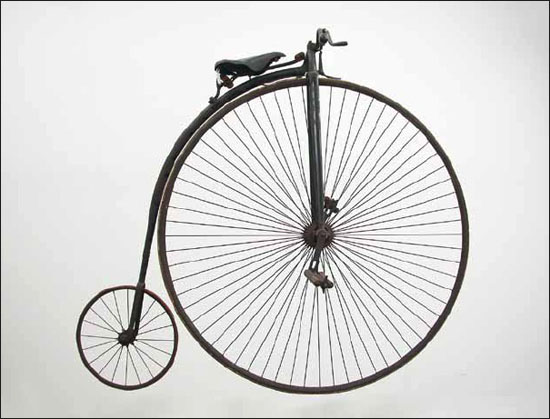
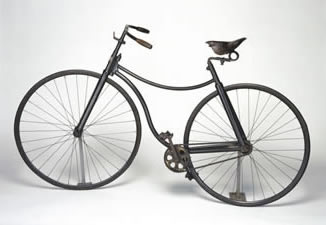
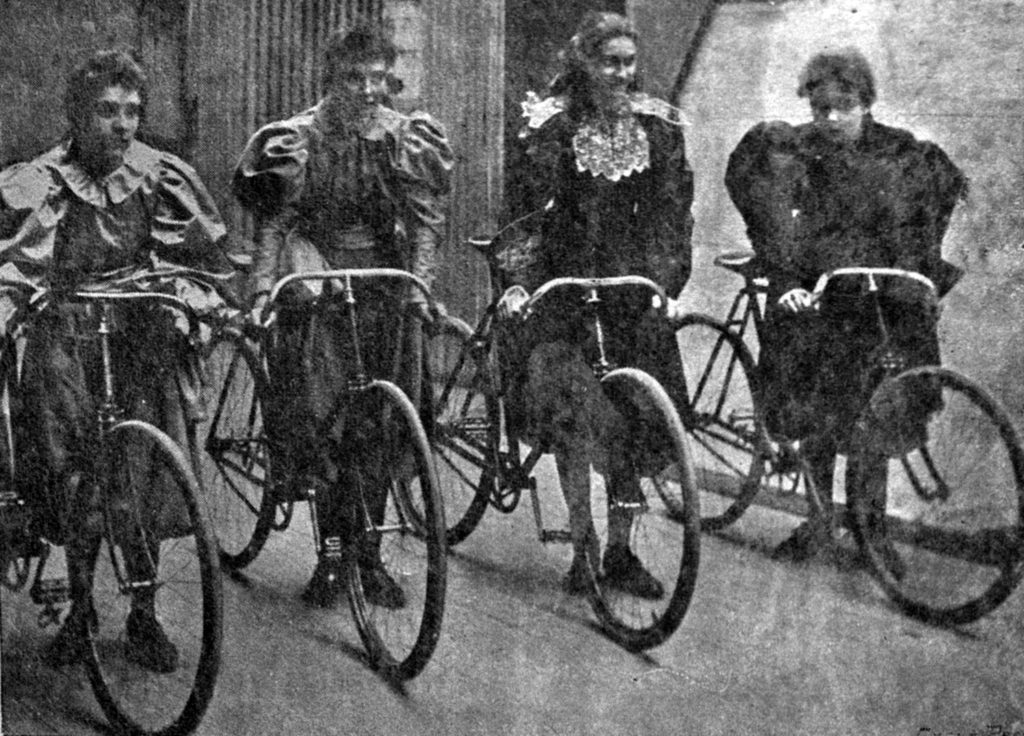
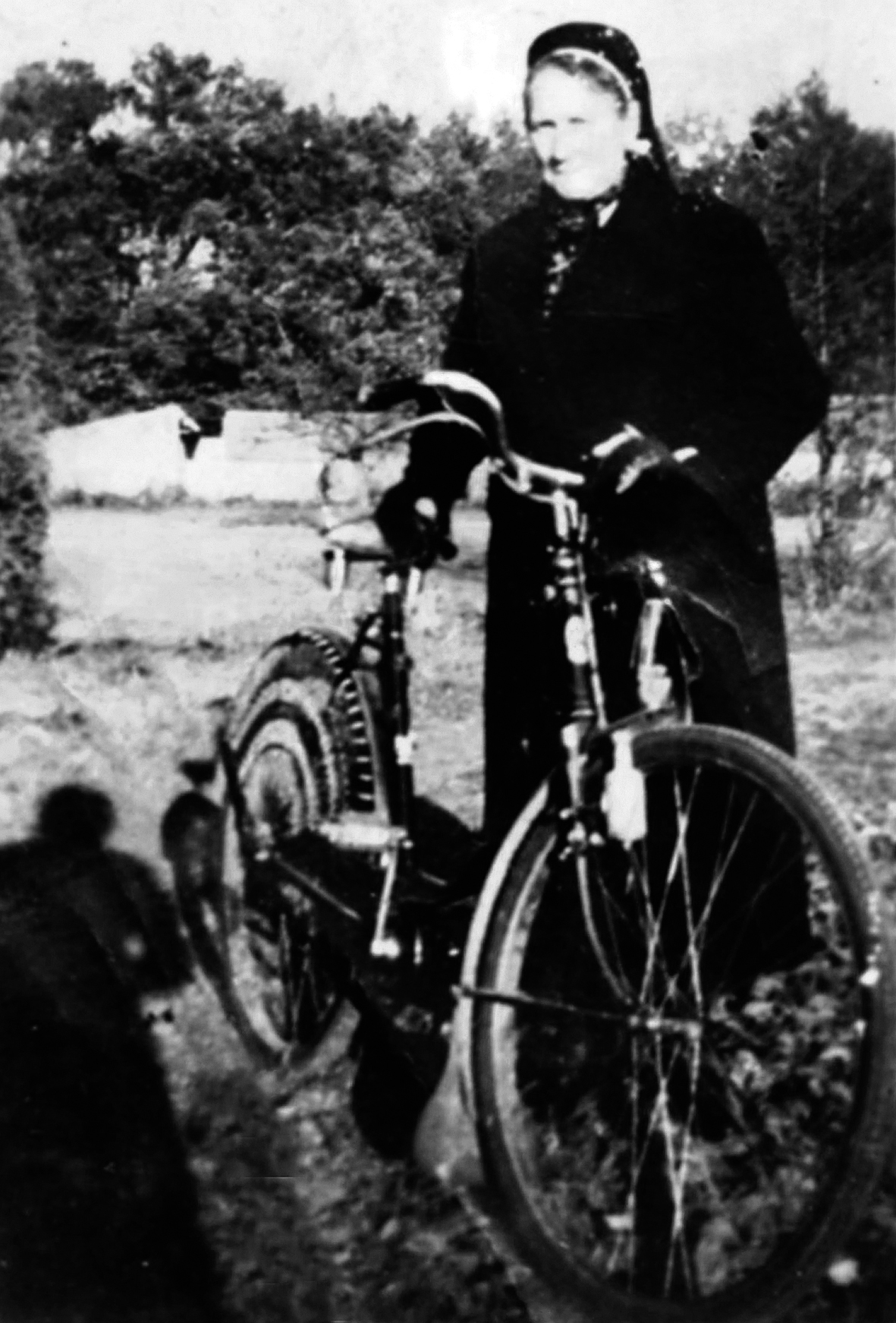
0 Comments
Trackbacks/Pingbacks